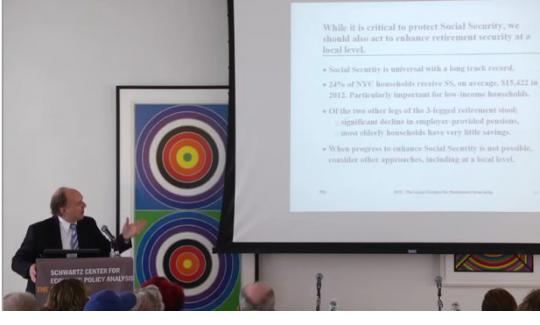“Confronting New York City’s Retirement Crisis” — This was the call for a conference on Tuesday, July 17, 2017, convened by the NYC Central Labor Council and the New School’s Schwartz Center for Economic Policy Analysis. Approximately 200 people crowded into the New School’s Wollman Hall for an analysis of the problem and consideration of possible solutions by speakers and panelists drawn from labor, academia, policy institutes, business and government.
59% of New Yorkers between the ages of 25 and 64 lack access to any retirement plans. Putting this in perspective, speakers explained that the backdrop for the retirement crisis both in New York and nationally is (1) a muted recovery from the deepest recession since World War Two, (2) growing and deep inequality marked by declining real wages for virtually all Americans but the top 1%, (3) the loss of union jobs and proliferation of low-income work, and (4) a mushrooming contingent labor force (part-time, temporary, seasonal, contract and leased workers, usually without benefits). When the figures for all these categories are broken down by race and gender, the crisis is even deeper for African-Americans, Latinos and women.
What is often referred to as the ‘three-legged stool’ of retirement security – pensions, saving and Social Security – has become alarmingly unstable. For most Americans, savings are minimal or non-existent. Proposals to cut Social Security have become a bipartisan ritual and defined benefit pension plans (let alone any pensions) are disappearing across the U.S. labor landscape.
 |
Both the New York State Comptroller, Thomas DiNapoli, and the NYC Comptroller, Scott Stringer, spoke. Public sector pensions, generally well-managed and healthy in both city and state, have become islands in a sea of private sector retirement insecurity. Given this reality, Stringer announced appointment of a special advisory group to examine the feasibility of a pooled pension fund for private sector workers that the city itself could manage. In this vein, much of the conference looked at examples of state and local initiatives to address retirement security, particularly for the private sector workforce.
However, the Director of Policy and Special Counsel for the national AFL-CIO, Damon Silver, playfully asked the audience to identify the one retirement initiative that is trusted, affordable, portable, annuitized, stable and protected from age and market risk. The answer, of course, is Social Security. Implicitly, at least, he was urging a major expansion of Social Security – an expansion that certainly would not preclude working on state and local initiatives.
PSC President Barbara Bowen picked up on Silver’s theme when she argued that “people will fight for a big idea where often they won’t fight for a small” one. “The labor movement,” she pointed out “is at its strongest ethically…, morally and politically when we take as our charge not only fighting to defend our pensions, but expanding and rethinking retirement security for everyone.”
Teresa Ghilarducci, the conference’s moderator and head of the New School’s Schwartz Center, has characterized pensions as “labor’s capital,” a concept that Bowen drew upon when she observed that presently trillions of dollars of pension wealth flow from labor to “concentrated wealth for the very rich.” Bowen reminded the conference of the imperative to change that narrative; to re-imagine a retirement system where labor’s wealth is used to insure and enlarge the future security of all working people.
Conference materials and a video of all the presentations and panels are available at www.economicpolicyresearch.org/index.php/wealth-insecurity-events/1470-june-17-confronting-new-york-city-s-retirement-crisis.

